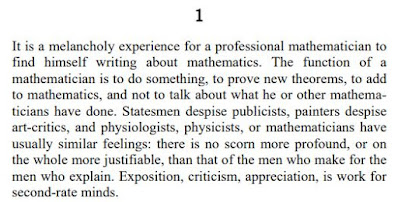Found on Facebook recently -- this snapshot of my syllable-count triangle from an earlier blog posting . . . I like the way that choosing words that conform to a pattern stimulates my thoughts.
 |
| From a blog posting back in 2018 |
Mathematical language can heighten the imagery of a poem; mathematical structure can deepen its effect. Feast here on an international menu of poems made rich by mathematical ingredients . . . . . . . gathered by JoAnne Growney. To receive email notifications of new postings, contact JoAnne at joannegrowney@gmail.com.
Found on Facebook recently -- this snapshot of my syllable-count triangle from an earlier blog posting . . . I like the way that choosing words that conform to a pattern stimulates my thoughts.
 |
| From a blog posting back in 2018 |
Like a circle, the "lazy 8" or infinity symbol -- shown below --never ends.

The mathematical ideas that I have mastered over the years spread out and infiltrate whatever I do and experience -- when the newspaper carrier throws my bagged Washington Post newspaper on the the porch in front of my second floor door, I wonder -- is the paper's curved path an arc of a circle, or a parabola? Or ???
Today, as I was sorting old newspapers and magazines into piles for saving or recycling or trashing, my items-to-sort included lots of copies of The New Yorker -- and the issue from May 16, 2022 had a page marked; I opened it to find the poem "FEATHERWEIGHT" by Chase Twichell. This poem reminded me how much my sewing activity connects to mathematics. I offer below the poem's opening stanzas -- followed by a link to the complete poem online (both print and audio versions).
FEATHERWEIGHT by Chase Twichell
At fourteen, I taught myself to sew
on a Singer Featherweight,
Summer weeks spent teaching English to Romanian students have helped me to learn of several of the country's fine poets and to get involved in a bit of translating. Romanian mathematics professor, Gabriel Prajitura (now at SUNY Brockport) -- whom I first met at Pennsylvania's Bucknell University when I was teaching nearby at Bloomsburg University -- worked with me to translate several mathy poems by Nichita Stanescu (1933-1983). The Summer/Autumn 2004 issue of Circumference: Poetry in Translation included "A lecture on the cube" and "A lecture on the circle." My blog posting on April 18, 2014 -- available at this link -- shares "A lecture on the circle" -- and I offer the other below:
A lecture on the cube by Nichita Stanescu
You take a piece of stone,
chisel it with blood,
grind it with Homer’s eye,
burnish it with beams
until the cube comes out perfect.
Blogger and teacher Sue VanHattum (blogger at Math Mama Writes) has been a frequent and valuable contributor to this blog -- find stuff at this link -- and Sue has recently alerted me to a poetic posting that she found on Facebook -- written and drawn by artist-illustrator (and orthodontist) Grant Snider whose pithy and entertaining words and pictures are found at the website Incidental Comics. Here is the opening portion of that visual-comic-poetic posting:
 |
| Opening lines of a visual poem by Grant Snider |
Snider's complete "How To Be a Triangle" is found in Incidental Comics at this link. Another recent posting -- "How to be a circle" -- is found at this link.
Japanese-American poet and retired math teacher Amy Uyematsu recently has published a new poetry collection, That Blue Trickster Time (What Books Press, 2022) and she has given me permission to share this fascinating mathy poem -- which vividly links the mathematical with the personal -- from that collection.
In Praise of the Irrational by Amy Uyematsu
: Kanpai (that's Japanese for “cheers”)
Hooray for the illogical,
this tale of built-in contradictions,
each perilous paradox that can
drive us bananas – and the curious
ways we keep the faith.
There's a logic to zero –
ask any mathematician, poet or priest -
but don’t expect them
to explain.
There's a profound dependability
in the irrational instincts
of women – yes us – all
tenderness, guts, and a fierceness
no man will ever fathom.
In his 1940 book-length essay, A Mathematician's Apology, eminent British mathematician G. H Hardy minimizes the importance of those who communicate mathematics to those outside the research community ... the book's opening paragraph is show below . . . it concludes with "Exposition, criticism, appreciation. is work for second rate minds."
 |
| The complete essay is available online here |
Sometimes I have time to browse my shelves and rediscover old favorites. Several of this blog's much-read poems have come from Scottish author Brian McCabe (Find blog search results at this link) -- and below I offer the first part of McCabe's two-part poem ("Two Quadrilaterals") entitled "The Restless Square."
Two Quadrilaterals by Brian McCabe
Part 1. The Restless Square
There was a square who yearned
to become something else.
It stretched its legs to mimic
an elegant rectangle but
lost its balance, leaned over
in a perilous parallelogram.
The term "Equation Poetry" is the title of an article by Radoslav Rochallyi -- and posted on 11/9/ 2021 here in the MATH VALUES blog. Rochallyi is a poet, essayist, and interdisciplinary artist living in Prague, Czech Republic and author of eight books of poetry. For Rochallyi, "mathematical" poetry is not poetry about mathematics but poetry whose form is determined by a mathematical rule.
For example, he uses the formula for the area of a circle -- a = π r² -- to form this example of Equation poetry:
And, from the binomial formula, BROWSE and ENJOY!
Back in January 2020 I gathered a list of titles of previous posts and posted it here at this link. And below I offer titles of postings -- with links -- since that time.
Recently I re-found -- in my copy of The Mathematical Magpie by Clifton Fadiman (1904-1999) (Simon and Schuster, 1962) -- these lines by Lewis Untermeyer (1885-1977):
EINSTEIN: A PARODY IN THE MANNER OF EDW-N MARKH-M
We drew our circle that shut him out,
This man of Science who dared our doubt.
But ah, with a fourth-dimensional grin
He squared a circle that took us in.
Untermeyer's lines first appeared in his Collected Parodies. Here is a link to a second edition (1997) of The Mathematical Magpie (for which the title page description includes: stories, subsets of essays, rhymes, anecdotes, epigrams . . . rational or irrational . . .)
 |
| Fano Plane diagram |
